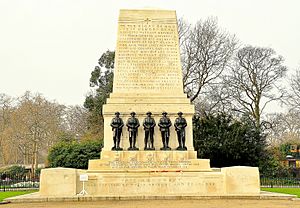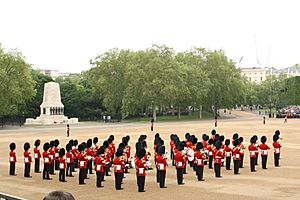Guards Memorial facts for kids

The memorial in 2011
|
|
| Coordinates | 51°30′16″N 0°07′46″W / 51.5044°N 0.1295°W |
|---|---|
| Location | London |
| Designer | H. Chalton Bradshaw |
| Type | War memorial |
| Material | Portland stone |
| Height | 38 feet |
| Opening date | 16 October 1926 |
| Dedicated to | War dead from the Guards Division |
The Guards Memorial is a special monument in London, United Kingdom. It is also known as the Guards Division War Memorial. You can find it on the west side of Horse Guards Road, across from Horse Guards Parade. This memorial remembers soldiers from the Guards Division who died in the First World War. It also honors members of the Household Division who died in the Second World War and other conflicts since 1918.
Contents
What Does the Guards Memorial Look Like?
The Guards Memorial was designed by H. Chalton Bradshaw. It is a cenotaph, which is a monument honoring people whose remains are elsewhere. The memorial is made of white Portland stone. It has a wide, short pillar, called an obelisk, that stands about 38 feet (11.6 meters) tall. This pillar sits on a stone base with three steps.
Bronze Statues: Honoring the Foot Guards
On the east side of the memorial, facing Horse Guards Parade, you will see five large bronze sculptures. These statues were created by Gilbert Ledward. Each statue represents one of the Foot Guards Regiments. They show guardsmen standing in a relaxed pose, holding their rifles. Each statue is a bit larger than life-size, about 7 feet 3 inches (2.2 meters) tall.
Below each statue, there is a stone carving of that regiment's badge. The statues were modeled after real guardsmen who were serving at the time. These included soldiers from the Grenadier Guards, Coldstream Guards, Scots Guards, Irish Guards, and Welsh Guards.
Other Bronze Panels and Inscriptions
The other three sides of the memorial have bronze panels. Two panels show military equipment. The panel at the back shows artillery in action. These statues and panels were made by the William Morris Art Bronze Foundry. The bronze used came from German guns that were melted down after the First World War.
Above the five statues, there is a special message written by Rudyard Kipling. His son, John, died while serving in the Irish Guards during the First World War. The inscription honors the officers and guardsmen who gave their lives for their country in the Great War (1914–1918). It also remembers other units that served with the Guards Division in France and Belgium.
Below this main message, there is another inscription that says, "This monument // was erected by their friends and comrades." The sides of the cenotaph also list the military units involved. The west side shows their battle honours, which are awards for bravery in battle.
Building the Memorial: Its Construction Story
The Birmingham Guild built the memorial. It cost about £22,000 to build. The letters on the monument were carved by Ernest Gillick.
The memorial was officially revealed on October 16, 1926. Field Marshal Prince Arthur, Duke of Connaught and Strathearn led the ceremony. A very old veteran, General Sir George Higginson, who was 100 years old and fought in the Crimean War, was also there. The Rev. H. J. Fleming, who was a senior chaplain for the Guards Division, dedicated the memorial. The Chaplain-General to the Forces, Rev. Alfred Jarvis, gave a blessing. After the ceremony, 15,000 serving and former guardsmen marched past the memorial.
During the Second World War, the memorial was damaged by bombs. Some of this damage was left unrepaired. These marks are seen as "honorable scars" from the war.
The Memorial's Later History
After World War II, another message was added below the statues. This inscription remembers those who died between 1939 and 1945. It also honors all members of the Household Division who died serving their country since 1918.
The Guards Memorial is a very important historical site. In 1970, it was given a Grade II listing. This means it is a building of special interest. In October 2014, its importance was recognized even more when it was upgraded to a Grade I listing. This is the highest level of protection for historic buildings in England.
Images for kids




